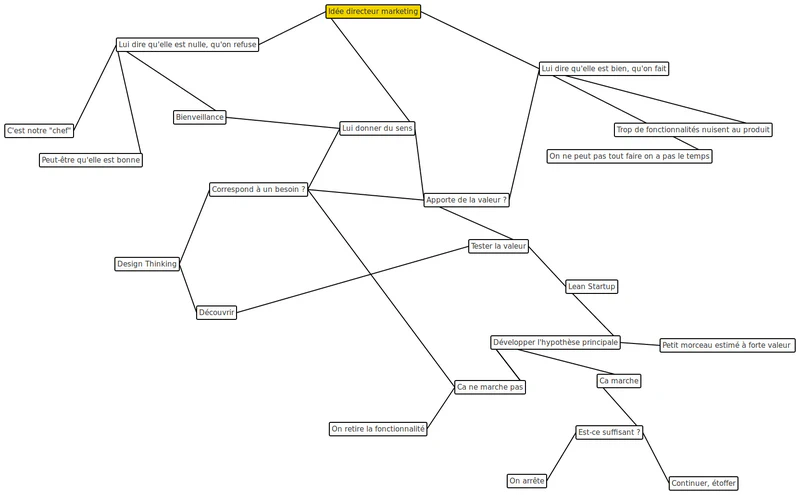Twice in two days with two clients, I’m presented with the same problem. “I’m a product manager and I have one or several marketing directors around me who have lots of ideas and who are quite uncontrollable. What should I tell them, how should I handle this flow of ideas?”
The marketing director has an idea
Tell them we systematically refuse it? Because it’s terrible ? Because we don’t like it? Because we have too many things to do? Not so simple, they might be your “boss”, and they’ll maybe flex their muscles. Not so simple, their idea might be good. An idea is positive, be kind, at least take a look.
On the other side: Tell them it’s good and we systematically do it? Integrate all requests? Not so simple, we won’t be able to do everything, we never have the means. Not so simple, too many features, too many ideas generally harm your product which can lose its meaning, and become obscure for its users. And all these features, they need to be maintained, they are a cost.
Give it meaning
This idea needs to be given meaning. Does it solve a need? Does it bring value? These are the questions that should be asked, that we should try to answer. Does it bring value? Confront it with your workshops and your design thinking tools, discover if this idea responds to something, and how to test your hypotheses.
If the idea doesn’t respond to a need and doesn’t seem to bring value, you have to say no. And explain why we believe it doesn’t bring value and doesn’t respond to a need. If the idea doesn’t respond to a need but seems to bring value, you have to try to move to the next step. If the idea responds to a need but doesn’t bring value, and we’re certain of this, you have to say no, otherwise you have to try. Same thing, you’ll have to explain why we’re sure it doesn’t bring value.
Despite all this, our analyses often remain hypotheses. And generally a hypothesis, might as well try to validate or invalidate it.
Try with the smallest piece that makes sense with the highest estimated value
Break down the marketing director’s idea into small autonomous elements that make sense, give this depth, and use the element with the best effort/value ratio to launch implementation. You must measure the value and compare with the expected one (more traffic, more conversion, more…). Does it work? we can ask ourselves: is it enough? If yes, we stop, if not, let’s expand our implementation. Same thing, with the smallest possible piece. It doesn’t work? We remove the feature deployed this way and we stop.
We build the minimum and test, as in lean startup. Impact mapping is ideal for charting this path to follow.
If you only have good ideas that bring value, and you can systematically measure them, you’re going to be famous, if you aren’t already.
Make the process transparent and give feedback
We explain everything to the marketing director and keep them informed of results, step by step. Ideally we only handle one idea at a time per marketing director.
Over time the relevance of your marketing director’s ideas will emerge. And a level of common understanding will appear. It will be easier to dialogue. Never forget that they can have a brilliant idea even if they’ve had very bad ones before, and vice versa.
I know that all this seems obvious to many. But you need to establish a dialogue based on small steps.
A small mind map
